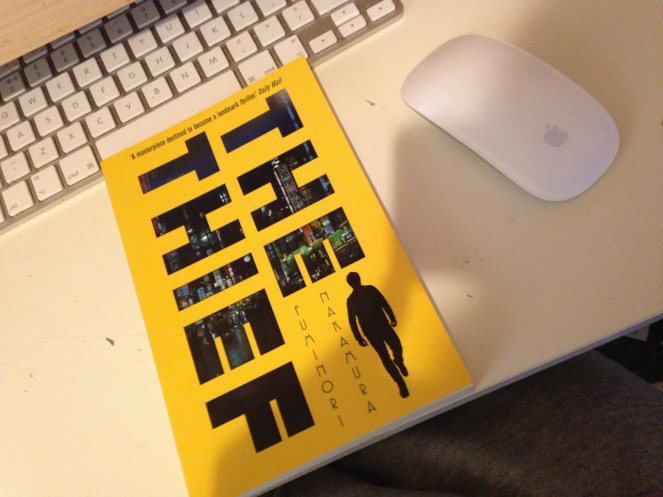
Week 2: Mainland Europe
Week 3: North Africa and the Middle East Which, now you’re all caught up, brings us to… Week 4: India, China, and Japan
 India first, and ‘The Venom of the Tarantula’ (1933) by Sharadindu Bandyopadhyay. Essentially an update of Poe’s ‘The Purloined Letter’ (1844) in that a room known to contain something — in this case the eponymous drug — is searched repeatedly with no success, and yet the substance under detection is clearly present because the crotchety old man in the room is still getting high. Watch though they might, his family cannot seem to restrict his access to the drug…so, howdunnit?
It’s an entertainingly-written story, and benefits from a good couple of potential false leads, but my difficulty with this type of thing is how the client always goes “We’ve thought of everything!” and then has clearly overlooked one gigantically obvious thing. And, indeed, just as I started thinking “Hmmm, this is remarkably similar to [insert title of another short story that fails to impress me]” the solution to this is pretty much exactly the solution to that. Now, yes, you’ll accuse me of knee-jerk reactionism on account of this similarity, but I just don’t buy these impossibilities that rely on blatant oversight. Something more subtle is called for in my world.
It’s worth mentioning that one of the real life impossibilities contained herein is not dissimilar to this: the actor Louis Calhern is locked in his hotel room every night following a rigorous search but is always found blind drunk in the morning. The solution to this is less subtle while also quite sly, and it made me laugh out loud.
India first, and ‘The Venom of the Tarantula’ (1933) by Sharadindu Bandyopadhyay. Essentially an update of Poe’s ‘The Purloined Letter’ (1844) in that a room known to contain something — in this case the eponymous drug — is searched repeatedly with no success, and yet the substance under detection is clearly present because the crotchety old man in the room is still getting high. Watch though they might, his family cannot seem to restrict his access to the drug…so, howdunnit?
It’s an entertainingly-written story, and benefits from a good couple of potential false leads, but my difficulty with this type of thing is how the client always goes “We’ve thought of everything!” and then has clearly overlooked one gigantically obvious thing. And, indeed, just as I started thinking “Hmmm, this is remarkably similar to [insert title of another short story that fails to impress me]” the solution to this is pretty much exactly the solution to that. Now, yes, you’ll accuse me of knee-jerk reactionism on account of this similarity, but I just don’t buy these impossibilities that rely on blatant oversight. Something more subtle is called for in my world.
It’s worth mentioning that one of the real life impossibilities contained herein is not dissimilar to this: the actor Louis Calhern is locked in his hotel room every night following a rigorous search but is always found blind drunk in the morning. The solution to this is less subtle while also quite sly, and it made me laugh out loud.
 Next up is ‘The Miracle on Christmas Eve’ (2016) from Taiwanese author Szu-Yen Lin, whose novel Death in the House of Rain has just been published by LRI. This is a beautifully child-like fable about the existence of Santa Claus that really benefits from simple, linear storytelling rooted in the clear, stark terms of how the very young see the world. A boy whose schoolmates mock his belief in Santa is encouraged by his father to invite the group to stay in the house on Christmas Eve and, after taping up and locking the windows and doors to a room, a Christmas tree and various presents manage to appear inside without any of the seals being broken.
I like the lack of razzmatazz here: the solution is actually pretty workable and feels likely in the circumstances. The sight of Santa and his reindeer flying across the moon I’m not so sold on, but the tree, presents, music box, and explanation work in a way that fits perfectly with the tone and intent of the story. I’m less a fan of the cloying letter which then turns up at the end to spell out that which was best left implicit, but I suppose others more socially adjusted than me will enjoy that aspect of things. All told, this bodes well for Death in the House of Rain, and I’m excited to see how he builds on this promise with a full-length mystery.
Next up is ‘The Miracle on Christmas Eve’ (2016) from Taiwanese author Szu-Yen Lin, whose novel Death in the House of Rain has just been published by LRI. This is a beautifully child-like fable about the existence of Santa Claus that really benefits from simple, linear storytelling rooted in the clear, stark terms of how the very young see the world. A boy whose schoolmates mock his belief in Santa is encouraged by his father to invite the group to stay in the house on Christmas Eve and, after taping up and locking the windows and doors to a room, a Christmas tree and various presents manage to appear inside without any of the seals being broken.
I like the lack of razzmatazz here: the solution is actually pretty workable and feels likely in the circumstances. The sight of Santa and his reindeer flying across the moon I’m not so sold on, but the tree, presents, music box, and explanation work in a way that fits perfectly with the tone and intent of the story. I’m less a fan of the cloying letter which then turns up at the end to spell out that which was best left implicit, but I suppose others more socially adjusted than me will enjoy that aspect of things. All told, this bodes well for Death in the House of Rain, and I’m excited to see how he builds on this promise with a full-length mystery.
 Two tales from Japan wind up this week. The first is ‘The Lure of the Green Door’ (1991) by Rintaro Norizuki, in which an avid book collector apparently commits suicide in his study having prophesied that “the green door will open” following his death. Said door is one of two that open from the study: this one having been stuck fast for years and years, and the other one being bolted on the inside and broken in by the emergency crew when the death was discovered. Norizuki’s amateur sleuth — called, er, Rintaro Norizuki — happens upon the case when the widow claims the dead man’s ghost appeared before her and asked her not to fulfil the terms of the will he wrote before his death.
It sounds a little busy, perhaps, but it’s one of the finest short form impossible crimes I’ve read in a long time. The introduction to this story says the solution is original, and it certainly doesn’t disappoint: at the moment of revelation I had a sudden realisation of what the answer was and again laughed out loud…only for the solution to actually be something else that made me laugh even louder. Possibly it involves rather too many people to work in reality — you’ll see what I mean — but this is simple, direct, perfectly fair, and genius-level brilliant, finding yet another wrinkle in how to resolve this type of impossibility. Ye gods, I hope we get more of Norizuki’s stuff in English before too long…
Two tales from Japan wind up this week. The first is ‘The Lure of the Green Door’ (1991) by Rintaro Norizuki, in which an avid book collector apparently commits suicide in his study having prophesied that “the green door will open” following his death. Said door is one of two that open from the study: this one having been stuck fast for years and years, and the other one being bolted on the inside and broken in by the emergency crew when the death was discovered. Norizuki’s amateur sleuth — called, er, Rintaro Norizuki — happens upon the case when the widow claims the dead man’s ghost appeared before her and asked her not to fulfil the terms of the will he wrote before his death.
It sounds a little busy, perhaps, but it’s one of the finest short form impossible crimes I’ve read in a long time. The introduction to this story says the solution is original, and it certainly doesn’t disappoint: at the moment of revelation I had a sudden realisation of what the answer was and again laughed out loud…only for the solution to actually be something else that made me laugh even louder. Possibly it involves rather too many people to work in reality — you’ll see what I mean — but this is simple, direct, perfectly fair, and genius-level brilliant, finding yet another wrinkle in how to resolve this type of impossibility. Ye gods, I hope we get more of Norizuki’s stuff in English before too long…
 And so, on the subject of authors whose work needs more translated, we finish with Soji Shimada and ‘The Locked House of Pythagoras’ (2013). Here we have a youthful Kiyoshi Mitarai — who would go on to solve The Tokyo Zodiac Murders (1981) — involving himself in the murder of a local artist and his mistress, both found inside a locked room inside a locked house surrounded by footprints which do not enter the premises. It is, no doubt, a uniquely Japanese take on this kind of mystery: when you pause a moment to consider things, there’s a striking presentation of the crime, and more than enough complexity and adversity to fuddle even the most incisive armchair detective.
And so, on the subject of authors whose work needs more translated, we finish with Soji Shimada and ‘The Locked House of Pythagoras’ (2013). Here we have a youthful Kiyoshi Mitarai — who would go on to solve The Tokyo Zodiac Murders (1981) — involving himself in the murder of a local artist and his mistress, both found inside a locked room inside a locked house surrounded by footprints which do not enter the premises. It is, no doubt, a uniquely Japanese take on this kind of mystery: when you pause a moment to consider things, there’s a striking presentation of the crime, and more than enough complexity and adversity to fuddle even the most incisive armchair detective.I’m pretty sure it doesn’t make a lick of sense — compare the elaboration here with the simplicity of Norizuki or Lin — but this is in no way intended to malign Shimada’s efforts: part of the joy of this subgenre is watching the great lengths someone can twist patterns from, and this is a sheer euphony of complexity and revelation. One slight complaint, and doubtless a cross-cultural thing, is that the precise workings of the window locks is important for a small aspect and it’s difficult to convey their operation in a written way…but, that’s fine. You’ll never figure the rest of it out anyway, so one extra complication is hardly going to undo it all. Seriously, though, why has no more Shimada been translated? He must have some absolute classics in his bibliography…when are we going to get them in English?! ~ Is there an overall theme to draw on here? There’s definitely more of a focus on personal space and architecture here than elsewhere in this collection — the use of the familiar trappings of the home, the safe and secure place where things are familiar and the outside world should not intrude, as a hotbed of the inexplicable and baffling. And this feels like a very deliberate attempt to bring the consequences of the crimes to bear on the people involved — there’s no palliative effect of it being on an anonymous train, or a beach, or the side of a mountain…these settings are close to the hearts of the people involved, and the ramifications of these crimes are intended to linger and be felt, you can’t help but sense, by people down the generations. If — and I dispute the claim myself — GAD simply was “snobbery with violence”, then the Eastern shin honkaku take on the puzzle plot is at last bringing back the personal substance of it all. Next week, to finish up, Australia and the Americas… Share this:





